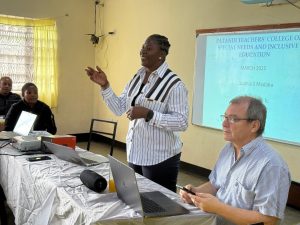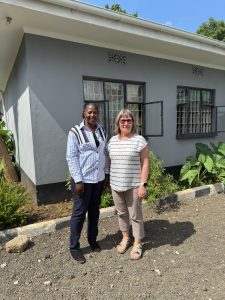March, 2025 - Update #5
Small Stories from Arusha 5
I Became a Believer in Inclusion
Today’s mentor training focused more on special education. The entire Arusha project has, for the past 12 years, been centered around special education, particularly on developing learning opportunities for deaf and hard-of-hearing children. In Tanzania – and elsewhere – the goal is to integrate children and young people with disabilities into so-called regular classroom education. I am not a special education teacher and do not have expertise in special education, so I have not really taken a stance on how it should be organized. However, I do know that the matter is not straightforward or easy to arrange.
In Inclusive Education, No One is Isolated or Left Behind
This was explained by Sophia S. Madaha from the Patandi Teacher’s College of Special Needs and Inclusive Education. I have understood that a teacher’s college is not at the university level, but students can apply after 11 years of schooling, even without a high school diploma. Sophia S. Madaha gave an inspiring presentation on how inclusive education is based on the idea that society consists of all of us, and that we humans differ in countless ways. However, every individual has the right to be valued and respected as a member of society, and everyone has the right to education. She presented the different levels of special education, based on how special education is structured.
- The lowest level is Denial, which means exclusion from education.
- The next level is Acceptance, which is rooted in “charity” and results in segregation – keeping education separate.
- The third level is Understanding, which leads to the integration of education while also providing special education based on individual needs.
- The fourth and highest level is Knowledge, which means education for all and full inclusion.

Photo: Sophia Madaha and Antti
Of course, this is a model that teachers then apply in practice, considering how to best arrange teaching for, for example, a deaf or visually impaired student. Here as well, the sign language interpreters participating in the training will also be teaching small groups in subjects where hearing-impaired students may face difficulties. Not everyone is in the same place at the same time all the time.
I also heard about Universal Learning Design (https://udlguidelines.cast.org/) for the first time. According to this approach, the goal is learner agency, which means meaningful and reflective learning, support and authenticity, as well as a strategic and action-oriented approach. If you’re interested, I highly recommend checking out the link for more on the framework!
I was deeply moved by the presentation and greatly appreciated how strongly Sophia, a teacher educator, believed in the power of education and everyone’s right to it. After the presentation, we discussed opportunities for collaboration, such as her students writing their theses on topics related to our project. I’m happy to help!
In Finland, Inclusion is Politics…
Today, I also came across a very fitting university announcement about an event titled “What’s Wrong with Inclusion – or Is There Anything Wrong? Has the Whole Term Been Misunderstood?” The event will take place on Wednesday, March 28, from 5:00 to 6:30 PM, and it is open to everyone:
https://flamma.helsinki.fi/fi/group/ajankohtaista/uutinen/-/uutinen/mika-inkluusiossa-mattaa-vai-mattaako-onko-koko-termi-kasitetty-vaarin/40639090
In Finland, inclusive education is highly politicized. However, from the perspective of Tanzania, what matters most is ensuring that everyone has the opportunity to participate in education and learn. Could it be that, in Finland, we are still in the early stages of truly accepting inclusion? And it is clear that there are still people who believe that education should keep the “normal” and “abnormal” students separate.
Liisa Ilomäki

Photo: Sophia and Liisa – In hopes of future collaboration